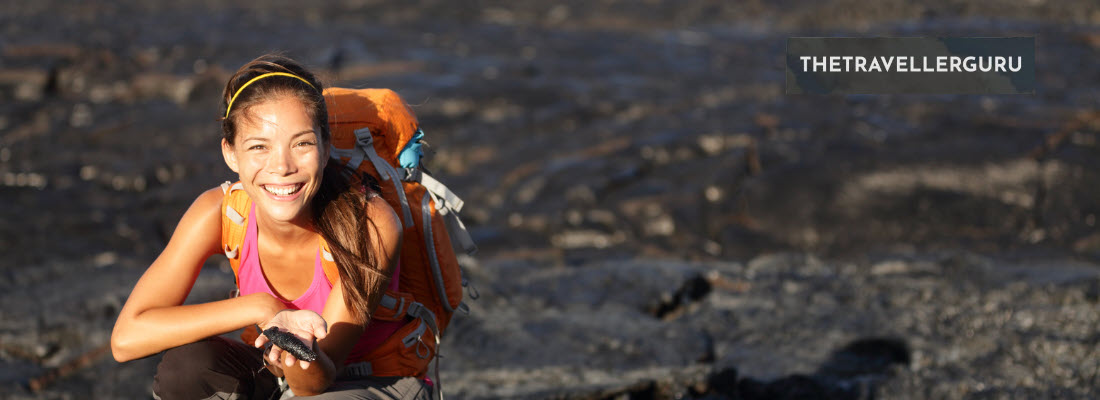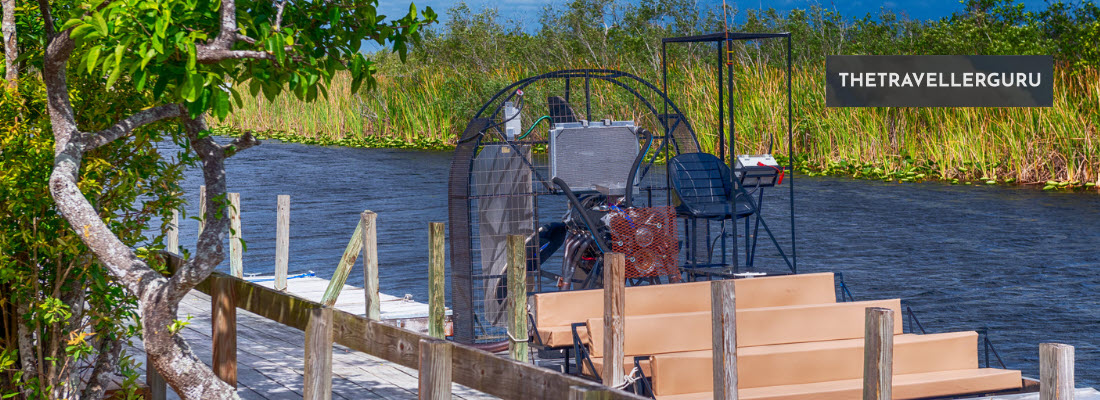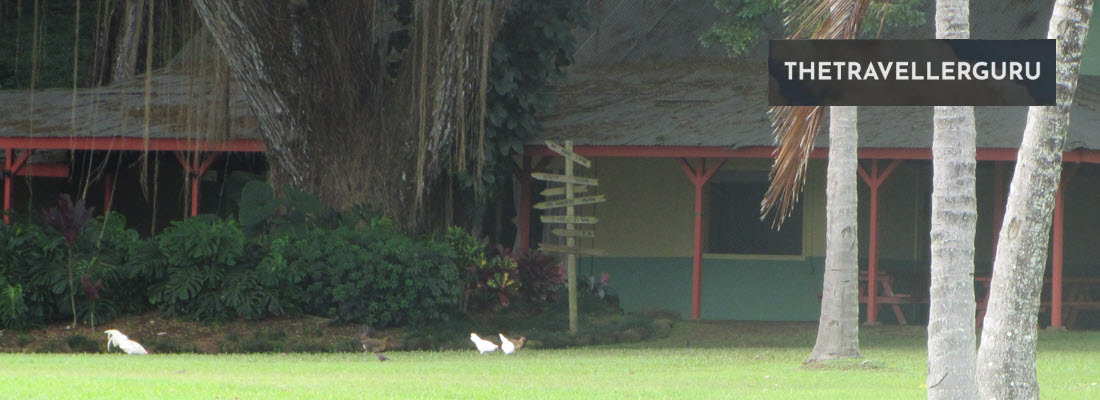Hey there hiking enthusiasts and welcome to my post where we will check out my 11 best hiking trails on the Big Island. With stunning views of the island’s volcanic landscape, lush rainforests, and pristine beaches hiking on the Big Island is an experience unlike any other.
Whether you’re a seasoned hiker or just starting out, the Big Island has a trail for you. From short, easy hikes to challenging multi-day treks, there’s something for everyone. And best of all, no matter which trail you choose, you’re sure to be rewarded with breathtaking views and a sense of adventure that can only be found in Hawaii.
Map Of The Best Hiking Trails On the Big Island
Use this map to identify the location of the best hiking trials on the big island listed below:
Best Hiking Trails on the Big Island
The Big Island of Hawaii offers some of the most breathtaking hiking trails in the world. Here are some of the top hiking trails on the Big Island that you should add to your must-visit list.
Check out these: Best Hiking Trails in Hawaii
1. Hawaii Volcanoes National Park
Hawaii Volcanoes National Park is a UNESCO World Heritage Site and an International Biosphere Reserve. It offers a unique opportunity to explore some of the world’s most active volcanoes, Kīlauea and Mauna Loa, and the diverse landscapes they’ve shaped over millennia.
- Trail Length: The park boasts numerous trails, ranging from short walks to multi-day treks.
- Difficulty: Varies from easy walks to challenging backcountry hikes.
- Terrain: The park’s trails traverse a wide range of terrains including rainforests, deserts and volcanic craters. Some paths lead to active volcanic areas where hikers can witness the dynamic processes of creation and destruction.
- Unique Features:
- Crater Rim Trail: Offers views of the Kīlauea Caldera and Halema’uma’u Crater.
- Nāpau Trail: Leads to the Nāpau Crater and provides views of Mauna Ulu and Pu’u O’o, two of Kīlauea’s most notable volcanic cones.
- Mauna Loa Summit Trail: A challenging hike that takes adventurers to the summit of the world’s largest volcano.
- Thurston Lava Tube (Nāhuku): A short walk that allows visitors to walk through a massive, ancient lava tube.
- Starting Point: Various trailheads are located throughout the park, with the Kīlauea Visitor Center serving as a primary starting point for many visitors.
- Tips: Due to the active volcanic nature of the park, it’s essential to check current conditions and any trail closures before embarking on a hike. Some areas may emit volcanic gases as well so it’s crucial to be aware of wind directions and potential hazards. Always stay on marked trails and respect all warning signs and barriers.
Hawaii Volcanoes National Park offers a once-in-a-lifetime hiking experience, allowing visitors to witness the raw power of nature and the ever-changing landscapes shaped by volcanic activity. Whether you’re exploring lush rainforests, walking on recent lava flows or standing on the summit of a volcano, the park promises an unforgettable adventure.
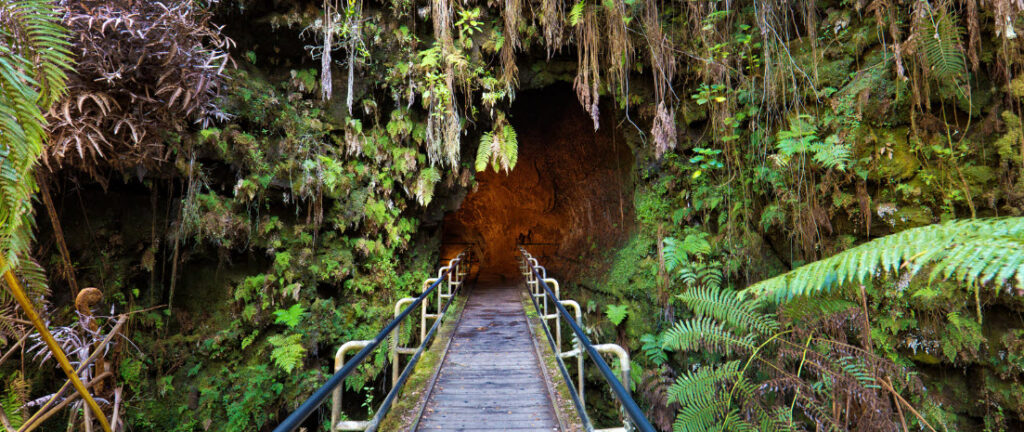
2. Pololu Trail
Situated at the northernmost point of Hawaii Island (The Big Island), the Pololū Trail offers a breathtaking journey into the Pololū Valley, one of the impressive valleys carved into the Kohala volcano.
The trail provides panoramic views of the valley, steep cliffs and the Pacific Ocean where the main attraction is the descent to a secluded black sand beach at the valley floor, surrounded by lush greenery and the towering cliffs of the Kohala region.
- Trail Length: Approximately 0.6 miles one way (1.2 miles round trip) to the black sand beach. For those seeking a more extended hike, there’s an option to continue to the next valley, Honokane Nui.
- Difficulty: Moderate, with some steep and potentially slippery sections, especially after rain.
- Terrain: The trail descends through a series of switchbacks offering stunning views of the valley and coastline. The path can be muddy, so proper footwear is essential.
- Unique Features: The trail offers views of the Pololū Valley’s black sand beach, the surrounding cliffs, and the ocean. During the winter months (December to March), the lookout point is an excellent spot for whale watching.
- Starting Point: The trailhead is located at the end of Akoni Pule Highway (highway 270), where the road ends at the Pololū Valley lookout.
- Tips: There are no public restrooms at the lookout or in the valley. The closest restrooms are at Keokea Beach Park, about 10 minutes from the overlook. The trail can get crowded, so visiting early in the day is recommended. Also, swimming at the beach can be dangerous due to high surf and currents, so caution is advised.
The Pololū Trail is a testament to the Big Island’s diverse landscapes, offering a mix of coastal views, lush valleys and geological wonders. As you embark on this hike, you’ll be treated to a serene and picturesque environment, making it a must-visit for nature enthusiasts.
3. Waimanu Valley
Waimanu Valley is a remote and pristine destination that offers hikers a challenging yet rewarding experience. The primary trail leading to the valley is the Muliwai Trail, which takes adventurers through diverse terrains including dense forests, steep switchbacks and river crossings.
- Trail Length: The Muliwai Trail is approximately 7.7 miles one way, making it a 15.3-mile round trip.
- Difficulty: Strenuous. The trail involves significant elevation changes with an ascent of over 1,200 feet within the first mile.
- Terrain: The trail begins with a series of switchbacks, known as the Z-Trail, that climb steeply out of Waipi’o Valley. After reaching the ridge’s top, hikers will then descend into Waimanu Valley. The path can be rocky, muddy and requires crossing several streams.
- Unique Features:
- Scenic Views: Throughout the hike, adventurers are treated to panoramic views of the Pacific Ocean, Waipi’o Valley and the surrounding cliffs and waterfalls.
- Camping: Waimanu Valley offers camping spots for those wishing to extend their stay in this remote paradise. A permit is required for camping.
- Starting Point: The trailhead starts from Waipi’o Beach, and the initial part involves crossing the Waipi’o stream.
- Tips: Due to the trail’s challenging nature, it’s essential to be well-prepared. Bring plenty of water, wear sturdy hiking shoes and be prepared for changing weather conditions. It’s also crucial to check the weather forecast as heavy rains can make stream crossings dangerous.
The Waimanu Valley hike is not for the faint-hearted but promises an unparalleled experience of Hawaii’s natural beauty and tranquility. The journey to the valley is as memorable as the destination itself with stunning vistas, cascading waterfalls, and the serene ambiance of Waimanu awaiting those who undertake the challenge.
Check out these: Best Waterfalls in Hawaii
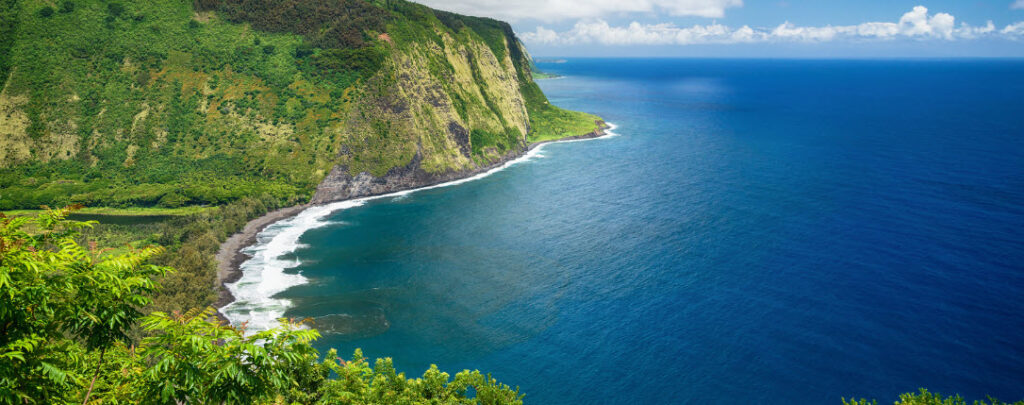
4. Kaumana Caves State Park
Located near Hilo on the Big Island of Hawaii, Kaumana Caves State Park offers visitors a unique opportunity to explore a lava tube created by an 1881 flow from Mauna Loa to provide a brief yet fascinating glimpse into the island’s volcanic history.
- Trail Length: Approximately 0.5 miles round trip
- Difficulty: Easy to moderate, with a descent into the lava tube being the primary challenge.
- Terrain: The main feature is the lava tube, which can be accessed by descending a metal ladder into a skylight. The interior of the tube is dark and can be rocky.
- Unique Features:
- Lava Tube Exploration: After descending the ladder, visitors can explore a short distance in both directions inside the lava tube. However, exploration is limited as the tube soon travels under private property.
- Park Amenities: The park offers restrooms and picnic tables making it a suitable spot for a brief rest or lunch.
- Starting Point: The trailhead is located off Hwy. 200 (Kaumana Dr.) between the 4 and 5-mile markers. The parking area is on the south side of the road, but the park entrance is on the north side.
- Tips: It’s essential to bring a flashlight if you intend to explore beyond the cave entrances and sturdy shoes are recommended due to the rocky terrain inside the lava tube.
Kaumana Caves State Park is a testament to the Big Island’s dynamic geological history and while the hike is relatively short, the opportunity to step inside a lava tube and witness the aftermath of a volcanic eruption from over a century ago makes it a memorable experience. Always prioritize safety, especially when exploring dark and uneven terrains and respect the park’s guidelines during your visit.
5. Mauna Loa Trail
Mauna Loa, the world’s largest shield volcano, offers a challenging and unique hiking experience on the Big Island. The Mauna Loa Trail provides adventurers with a chance to traverse vast lava fields, witness the stark beauty of volcanic landscapes and stand atop one of the most iconic summits in the Pacific.
- Trail Length: The trail, from trailhead to summit, is about 19.5 miles in length.
- Difficulty: Strenuous. The trail boasts approximately 7,000 feet of elevation gain, presenting a long, steady and generally gradual climb.
- Terrain: The trail is marked by ahu (rock cairns) and is nearly entirely above the tree line, making its way across recent lava flows. The landscape is stark, with little to no vegetation, exposing hikers to direct sunlight with very few shaded areas.
- Unique Features:
- Volcanic Landscape: The trail offers a firsthand look at the vast lava fields and the unique geological formations created by Mauna Loa’s eruptions.
- Summit Views: From the summit, hikers can enjoy panoramic views of the Big Island including the active Kilauea caldera.
- Red Hill Cabin: Located at about 10,000 feet elevation, this cabin serves as a resting point for many hikers. It requires a permit for overnight use.
- Starting Point: The Mauna Loa trailhead, which begins at an elevation of around 6,600 feet.
- Tips: Due to the trail’s challenging nature and high elevation, it’s essential to be well-prepared. Bring plenty of water as there are no reliable sources of fresh water along the trail. Sun protection is crucial due to the exposed terrain and it’s also advisable to acclimatize to the altitude before attempting the hike, especially if planning to reach the summit.
The Mauna Loa Trail offers a once-in-a-lifetime hiking experience allowing visitors to witness the raw beauty and power of one of the world’s most massive volcanoes. The journey to the summit is as awe-inspiring as the destination itself, with vast lava fields, unique geological formations and breathtaking views awaiting those who undertake the challenge. Always prioritize safety and ensure you have the necessary permits and preparations for the hike.
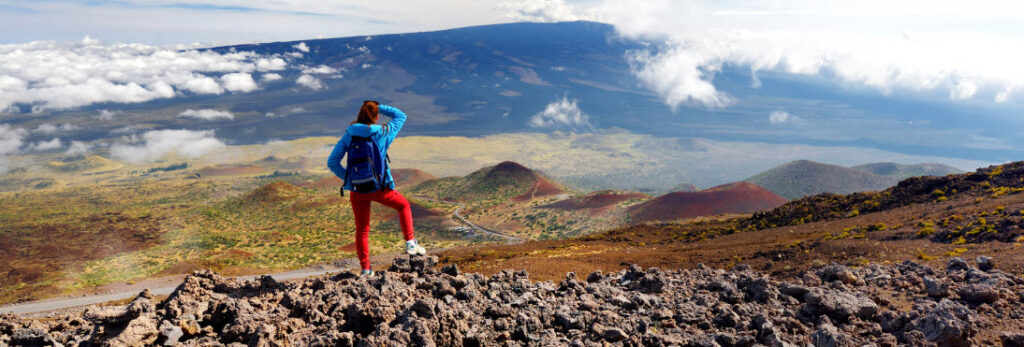
Book your hiking trip to the Big Island here!
6. Green Sand Beach Hike
Located near the southern tip of the Big Island of Hawaii, the Green Sand Beach, also known as Papakolea, is one of only a few green sand beaches in the world. The unique olive-green color of the sand is due to the presence of the mineral olivine however reaching this unique beach requires a hike across rugged coastal terrain.
- Trail Length: Approximately 2.5 to 3 miles one way, making it a 5 to 6-mile round trip.
- Difficulty: Moderate. While the trail is not particularly steep, it can be hot and exposed with little shade along the way.
- Terrain: The trail traverses open coastal terrain with some rocky and sandy sections. The path is marked, but it’s essential to be cautious and stay on the designated trail.
- Unique Features:
- Olivine Sand: The main attraction is the beach itself, with its unique greenish hue, a result of the erosion of olivine-rich lava.
- Coastal Views: Along the hike, adventurers are treated to panoramic views of the Pacific Ocean and the rugged coastline.
- Starting Point: The trailhead starts from a parking lot near South Point Road.
- Tips: Due to the trail’s exposed nature, it’s essential to bring sun protection, plenty of water and sturdy shoes. The area can be windy, so be prepared for changing weather conditions and it’s also advisable to start the hike early in the morning to avoid the midday sun.
The Green Sand Beach Hike offers a unique opportunity to visit one of the world’s rarest beaches with the journey as memorable as the destination itself.
7. Makalawena Beach Hike
Makalawena Beach, located within the Kekaha Kai State Park, is a hidden gem that offers pristine white sands and clear blue waters. The beach is not directly accessible by road, making the hike a necessary journey to reach this secluded paradise.
- Trail Length: There are two primary routes to the beach. The southern route is approximately 2.2 miles round trip, while the northern route is about 4 miles round trip.
- Difficulty: Moderate. The trail can be rocky and uneven in places, with some sandy sections.
- Terrain: The trail traverses lava fields, transitioning into sand dunes covered with pōhuehue (beach morning glories) and offers expansive views of the coastline and surrounding landscape.
- Unique Features:
- ʻŌpaeʻula Pond: Located behind Makalawena Beach, this twelve-acre pond is a National Natural Landmark that protects nesting and breeding areas for native Hawaiian birds. It’s surrounded by private property, so visitors are advised to stay on the beach.
- Secluded Bays: The beach comprises several bays with white sand and shade from palm trees offering a serene environment for relaxation.
- Starting Point: There are two primary trailheads. The northern trailhead is located just south of the paved road to Kua Bay, between mile markers 88 and 89. The southern trailhead is found between the 90 and 91 mile markers on Hwy. 19.
- Tips: The trail can be exposed to direct sunlight, so it’s essential to bring sun protection, plenty of water and sturdy shoes. As always, pack out any trash to maintain the beach’s pristine condition.
The Makalawena Beach Hike leads adventurers to one of the Big Island’s most beautiful and secluded beaches. The journey offers a unique blend of rugged volcanic landscapes and soft sandy shores, culminating in a beach experience that feels like a well-kept secret.
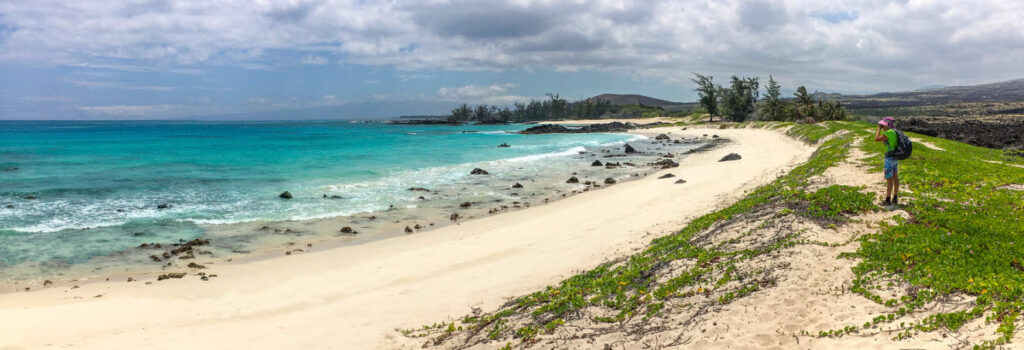
8. Black Sand Beach Hike
Black Sand Beaches are a result of volcanic activity where the black sand is formed by the rapid cooling and hardening of lava as it hits the ocean. These beaches offer a unique and stark contrast to the typical white and golden sands found elsewhere.
- Trail Length: The exact length can vary depending on the specific black sand beach and the trail associated with it. Some trails, like the one at Waianapanapa State Park in Maui, are relatively short, around 0.7 miles out-and-back.
- Difficulty: Generally easy to moderate, depending on the specific trail and location.
- Terrain: The trails leading to black sand beaches often traverse coastal terrains with some rocky and sandy sections. The beaches themselves can be a mix of fine black sand and larger volcanic pebbles.
- Unique Features:
- Volcanic Sand: The main attraction is the beach itself, with its unique black hue, a result of volcanic activity.
- Coastal Views: Many of these trails offer panoramic views of the Pacific Ocean and surrounding landscapes.
- Wildlife: Depending on the location, visitors might spot sea turtles basking on the black sands or other native wildlife.
- Starting Point: The trailhead starts from designated parking areas or access points near the beach.
- Tips: While the trails might be relatively short, it’s essential to bring sun protection and water, especially if planning to spend time on the beach. As always, respect the environment and wildlife and avoid disturbing any nesting sea turtles or other animals.
Black Sand Beach hikes offer a unique opportunity to witness the aftermath of volcanic eruptions and the ever-changing landscapes they shape. The stark contrast of the black sands against the blue ocean waters makes for a memorable and picturesque experience.
9. Kealakekua Bay Hike
Kealakekua Bay is a historically significant site and a marine life conservation district. The bay is renowned for its clear waters, vibrant coral reefs and diverse marine life. The primary trail leading to the bay is the Captain Cook Monument Trail, which offers hikers a blend of history, natural beauty and stunning coastal views.
- Trail Length: The Captain Cook Monument Trail, also known as the Ka’Awaloa Trail, is approximately 4 miles round trip.
- Difficulty: Moderate. The trail involves a descent to the bay and a subsequent ascent on the return, with an elevation change of about 1,300 feet.
- Terrain: The trail traverses a mix of rocky paths and grasslands offering sweeping views of the Pacific Ocean and the surrounding coastline.
- Unique Features:
- Captain James Cook Monument: The trail ends at a monument dedicated to Captain James Cook, the British explorer who first made contact with the Hawaiian Islands.
- Snorkeling Opportunities: Kealakekua Bay is one of the best snorkeling spots on the Big Island, with clear waters and abundant marine life.
- Starting Point: The trailhead is located off Napo’opo’o Road.
- Tips: The trail can be exposed to direct sunlight, so it’s essential to bring sun protection, plenty of water and sturdy shoes. Given the bay’s status as a marine life conservation district, it’s crucial to respect the environment and avoid touching or disturbing the coral and marine life as well.
The Kealakekua Bay Hike offers a unique blend of history and natural beauty. The journey to the bay provides panoramic coastal views while the destination itself promises a serene beach experience and a glimpse into Hawaii’s rich history.
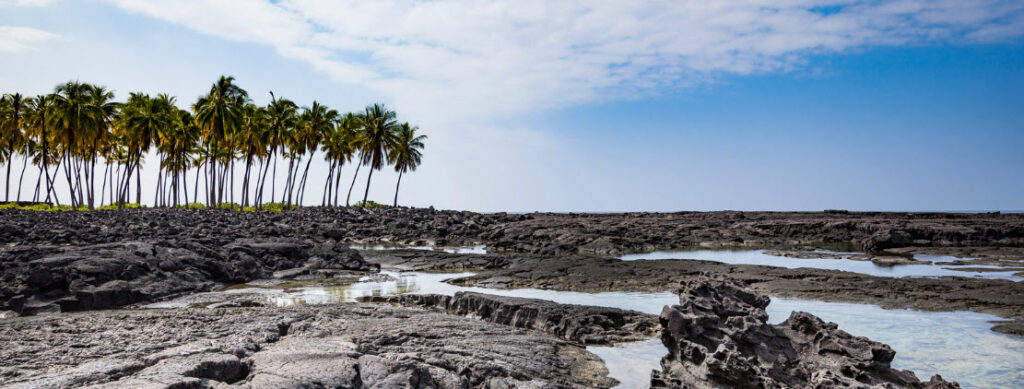
10. Kiholo Bay Scenic Overlook Hike
Kīholo Bay is a picturesque bay known for its calm, turquoise tidepools. The bay is a great place to spend a beach day, especially for those seeking a more off-the-beaten-path experience where conservation efforts over the years have enhanced the location’s beauty and ecosystem.
- Trail Length: Approximately 2.8 miles round trip.
- Difficulty: Moderate. The trail traverses rocky coastlines and sandy areas.
- Terrain: The hike offers a mix of rocky coastlines, picturesque trees and sandy beaches. The trail provides expansive views of the bay and the Pacific Ocean.
- Unique Features:
- Wainanali’i Lagoon: A brackish turquoise lagoon that was once a gigantic fishpond constructed by Kamehameha I in 1810. The lagoon provides a fantastic spot for a swim and is frequented by honu (green sea turtles).
- Keanalele: A lava tube filled with a mix of freshwater and saltwater. It’s now illegal to enter any cave in Kīholo, but the sight itself is intriguing.
- Starting Point: The trailhead is located just past the scenic area adjacent to mile marker 82 on Hwy 19.
- Tips: The trail can be exposed to direct sunlight, so it’s essential to bring sun protection, plenty of water and sturdy shoes. Respect the environment and avoid disturbing any wildlife, especially the honu (green sea turtles) that frequent the bay.
The Kīholo Bay Hike offers a serene experience, allowing visitors to explore a beautiful bay with unique geological and historical features. The journey provides a blend of coastal views, tidepools and a glimpse into Hawaii’s rich history and conservation efforts.
11. Ka Lae Hike
Ka Lae, also known as South Point, is the southernmost point of the Big Island of Hawaii and the United States. This area is steeped in history and offers a unique blend of natural beauty, archaeological sites and stunning coastal views. The hike to South Point provides a glimpse into Hawaii’s rich history and the vast Pacific Ocean.
- Trail Length: Approximately 3 miles round trip.
- Difficulty: Moderate. The trail traverses rocky coastlines and open fields.
- Terrain: The hike offers a mix of rocky paths, picturesque bays and open fields with expansive views of the Pacific Ocean and the surrounding coastline.
- Unique Features:
- Historical Significance: Ka Lae is believed to be the landing site of the first Polynesian settlers who arrived in Hawaii around 1,500 years ago.
- Fishing and Cliff Jumping: The area is known for its fishing opportunities and the brave souls who cliff jump from the southernmost point.
- Open-Ceiling Sea Cave: A unique geological feature in the area.
- Starting Point: The trailhead is located off South Point Road which is a paved but narrow road leading to the southernmost point.
- Tips: The trail can be exposed to direct sunlight and strong winds, so it’s essential to bring sun protection, plenty of wate, and sturdy shoes. Respect the environment and avoid disturbing any archaeological sites or wildlife.
The Ka Lae (South Point) Hike offers a serene experience allowing visitors to explore the southernmost point of the United States. The journey provides a blend of coastal views, unique geological formations and a glimpse into Hawaii’s rich history and cultural significance.

Book your hiking trip to the Big Island here!
Hiking Safety and Guidelines
When it comes to hiking on the Big Island, it’s important to prioritize your safety. Here are some guidelines to follow:
- Wear appropriate hiking shoes to prevent slipping and tripping on uneven terrain.
- Apply sunscreen to protect your skin from the strong Hawaiian sun, even on cloudy days.
- Bring plenty of water and snacks to stay hydrated and energized during your hike.
- If you’re hiking alone, make sure to let someone know where you’re going and when you plan to return.
- Follow the Leave No Trace principles to minimize your impact on the environment and preserve the natural beauty of the trails.
- Consider bringing a hiking partner for added safety and enjoyment.
By following these simple guidelines, you can have a safe and enjoyable hiking experience on the Big Island.
Permits and Other Information
Before embarking on any hiking trail on the Big Island, it’s important to know that some trails require permits. You can obtain permits at trails.ehawaii.gov ad its important to bring your ID with you to get through.
If you’re unsure of which trails require permits, you can check out the “Permit hikes – Big Island” list on AllTrails. This list provides hand-curated trail maps, driving directions and detailed reviews from hikers, campers and nature lovers alike.
Conclusion
There you have it, 11 best hiking trails on the Big Island. As usual, let me know of your experiences here or if there is anywhere you think I need to add.
Also, please do not hesitate to comment below if you have any questions, concerns, or corrections or would like me to check anything else out for you.
Until next time.
Have fun
Paul
